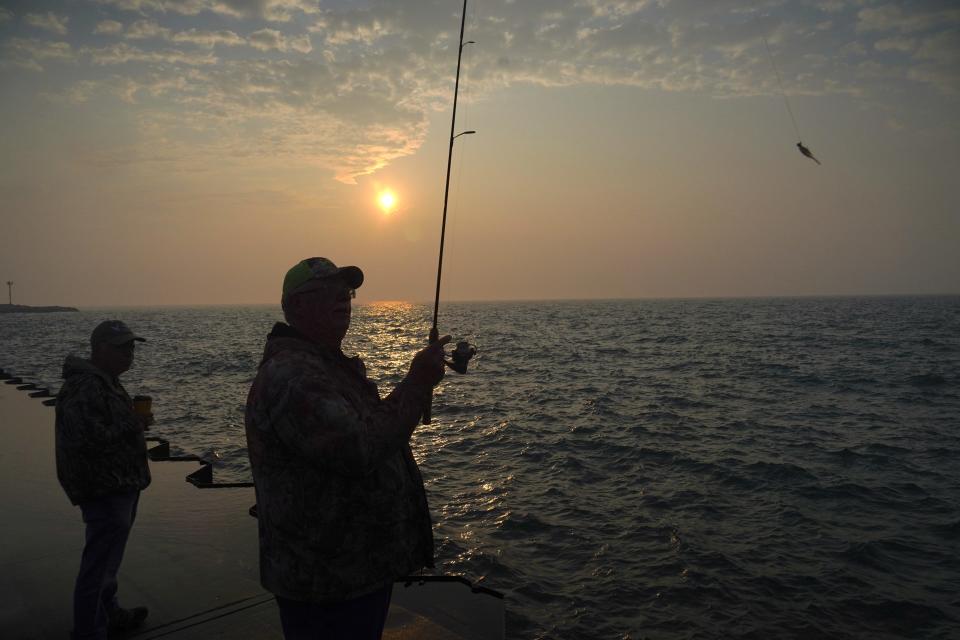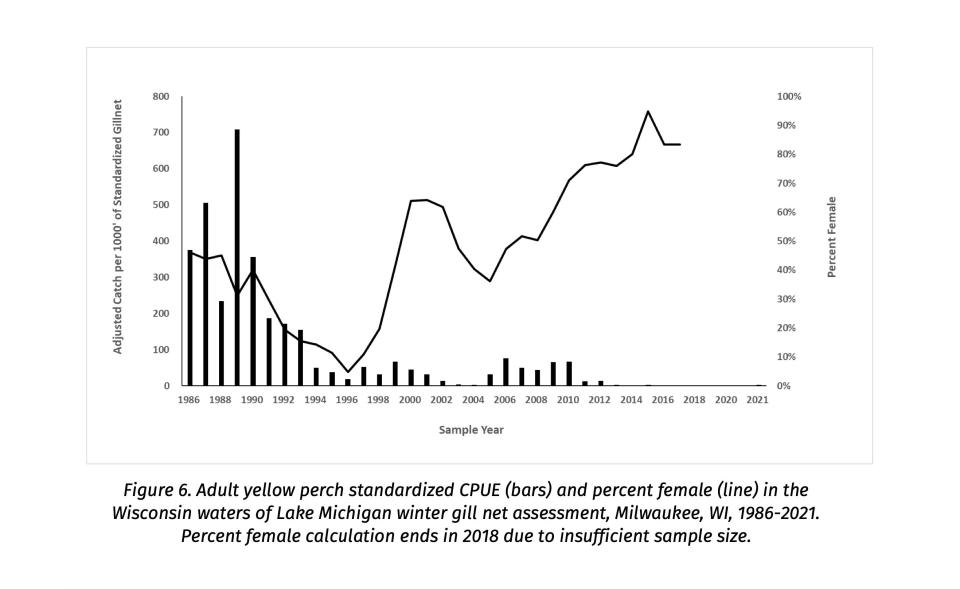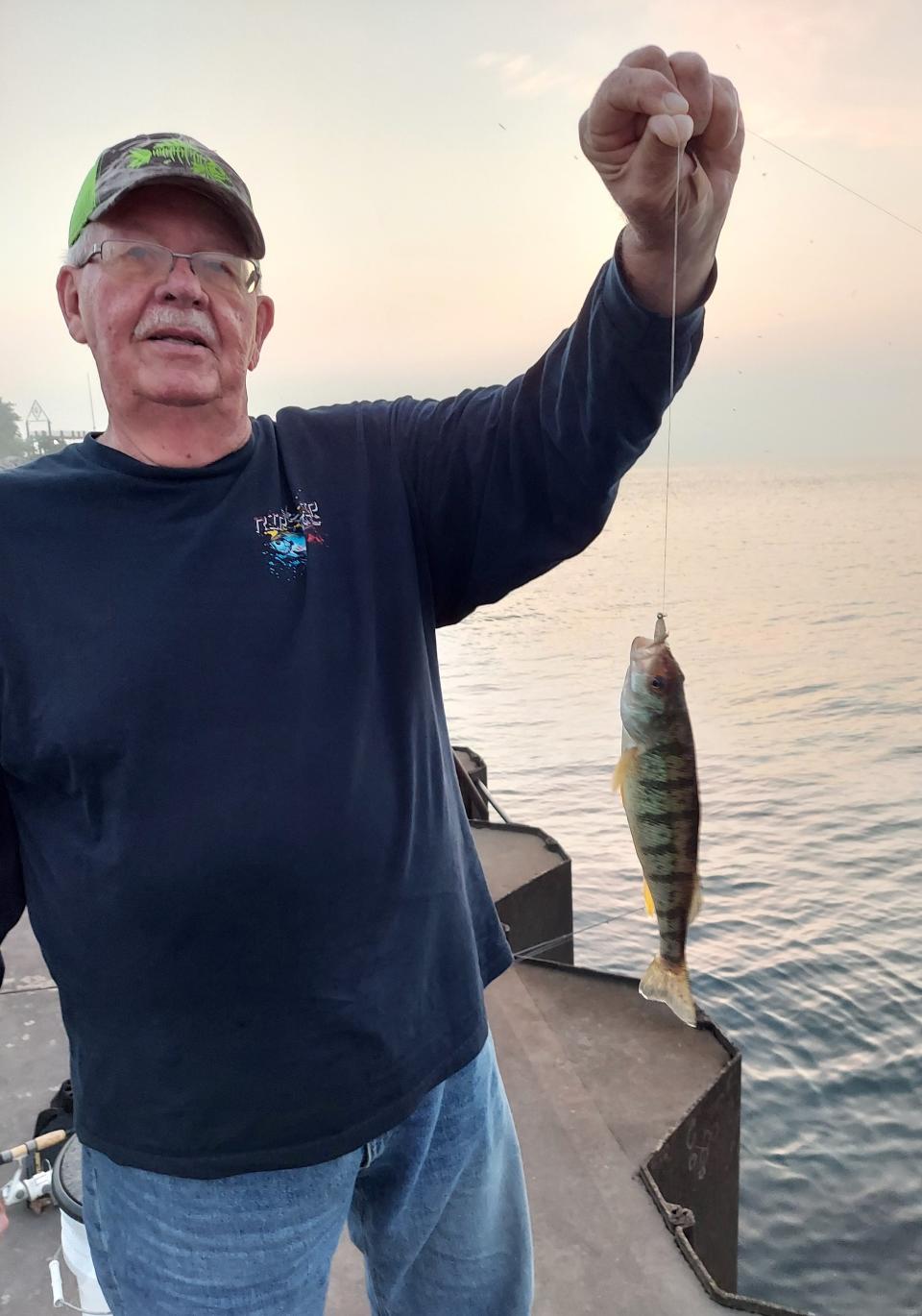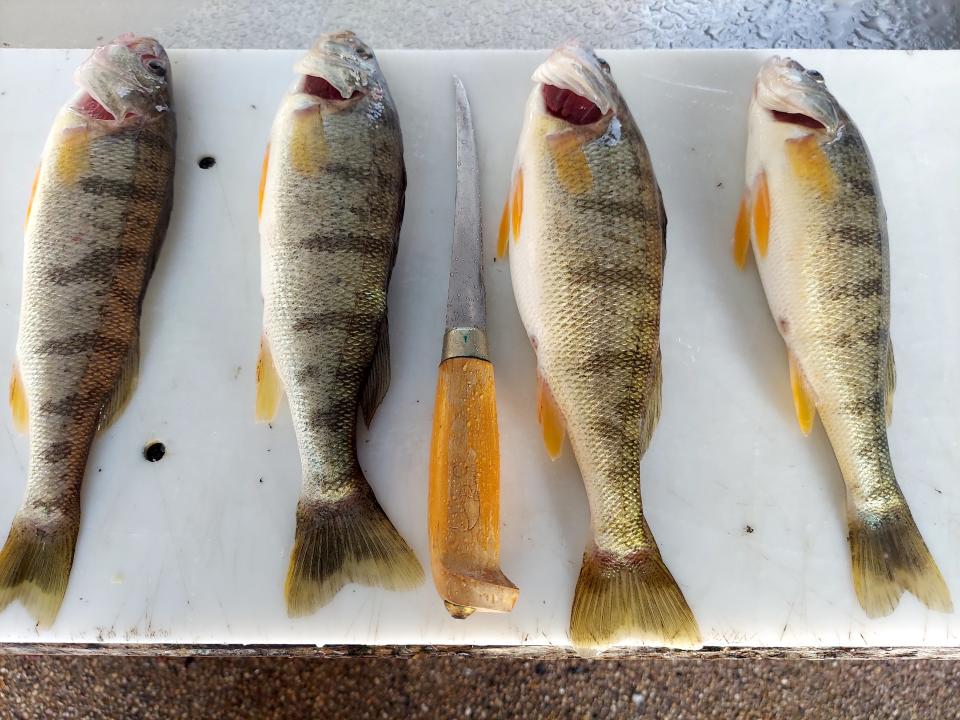Smith: The "fish of the people" persists on Lake Michigan but numbers remain low

RACINE - At 5:30 a.m. Thursday a southeast wind drove waves from Lake Michigan into the corrugated sea wall, periodically sending columns of spray 10 feet high and onto the South Pier walkway.
The watery eruptions weren't as predictable as Old Faithful at Yellowstone National Park, but in combination with a rising sun they added to the scenic quality to the lakefront.
Refreshing, too.
Every few minutes the lake would serve up just the right wave to hit Tim Hansen of Racine and me as we stood and fished on the pier.
"I've been getting a reading of 61 degrees for the water temperature," Hansen said as a fresh dose was gifted on our feet. "Feels about right."
'The perch is the fish of the people'
The Great Lake has water in abundance, of course. Our angling quest was for something that's become relatively rare in recent decades — yellow perch.
The native fish was arguably the most valuable species in Lake Michigan over the last 200 years. It was commercially-caught and formed the foundation of Wisconsin's Friday night fish fries.
And it was highly prized by sport fishermen from Kenosha to Door County.
In the middle 1900s, it was common for hundreds of anglers to line Milwaukee's piers, cane poles in hand, fishing for perch.
"The perch is the fish of the people," Ron Anton, the late conservationist from Racine, declared at a 1996 Natural Resources Board meeting as perch numbers were dropping and protective regulations were being debated.
Yellow perch numbers experience significant decline
The Department of Natural Resources tried to stem the losses. In 1996, the sport bag limit was reduced to five perch per day and the commercial fishery was closed.
But larger forces were at play and the Lake Michigan ecosystem, already compromised from decades of pressure from aquatic invasive species such as alewife and sea lamprey, suffered further as zebra and quagga mussels blanketed the lake's bottom and filtered out food web-altering amounts of plankton.
Yellow perch numbers continued to decline from the 1990s through the 2010s, mostly due to recruitment failure, or very low survival of young perch.
Following the appearance of the invasive mussels in the 1990s, scientists documented the significant decline of key members of the lake's ecosystem such as Diporeia, a zooplankton species and prime food source for adolescent perch.
As Dave Jude, a Great Lakes scientist based at the University of Michigan, told me at a 1994 perch conference: "The young perch are starving."

Although the perch hasn't been the beneficiary of a proactive fisheries management program similar to what has been done for decades to rehabilitate lake trout in Lake Michigan, it hasn't gone extinct, either.
Every few years the perch bring off a larger-than-average year class. The most recent was in 2016, according to Aaron Schiller, DNR Lake Michigan fisheries biologist.
And although perch numbers remain low, the most recent DNR graded mesh assessment (annual netting done in winter in water east of Milwaukee) found fish from four year classes: 2015, 2016, 2019 and 2020.
The 2022 DNR Lake Michigan yellow perch summary put it this way: "Yellow perch populations remain low and struggle to produce significant year classes. Yellow perch from the 2016 cohort were captured during the spawning survey in 2021 and in the graded mesh assessment in December of 2021 and are also showing up in the creel surveys. Although the total catch is low, the 2016 cohort is the most recent successful cohort in the last 10 years. They have been detected in multiple years of spawning surveys and hopefully will be able to contribute to the next significant cohort. Our YOY surveys for 2021 were extremely limited, but did detect some yellow perch. Further evaluation of the strength of the 2021 cohort will be needed. The strength of the 2021 cohort will be evident in later years if they show up in other surveys. Overall, catch remains low and the population is relying heavily on one or two years of successful recruitment."
The variability of the year classes is likely tied to food availability and nutrients, said Dr. Russel Cuhel of the UWM School of Freshwater Sciences.
A 'perfect storm' of events
Cuhel has observed better perch year classes in years when a "perfect storm" of events, including weather and water turbulence, helped keep food items needed by young yellow perch in nearshore waters at the crucial post-hatch time.
Interestingly, 2023 could be serving up such conditions. Cuhel and Schiller said they've been finding high amounts of diatoms, a type of algae that is eaten by young perch and other fish, this year in the Milwaukee harbor.

That is music to the ears of Hansen and other perch anglers who refuse to give up on the native fish or the lifestyle it supported.
Hansen, now retired, fishes nearly every morning of the season along the Racine shore.
"It's a fish here or there," Hansen said. "Nothing like the old days, but it's still fun and it helps us keep going."
The "us" is a group of regulars who call themselves the faculty of "UCLA" (University Closest to Lake Avenue).
In addition to Hansen, its regular members include Dave Buresh, Bob Eaton, Will Hagen, Dan Scholzen, Dave Simonsen and Angelo Trentadue, all area residents and all retired.
They gather each morning along the Racine lakefront from about 5:30 to 7:30 to fish, tell stories and share coffee.
"You better have a thick skin or you won't last long down here," Hagen said.
Most of the men have known each other for 40 or more years, long enough to remember when perch fishermen covered the piers.
"There aren't any young anglers out for perch anymore," Hagen said. "That should be a concern to everybody."
Reasons for optimism
The members of UCLA rely on Hansen as a perch barometer. If he catches a few, they'll head out to the pier, too.
Hansen caught one perch most days of last week, then four on Friday.
For tactics, we used 2- to 3-inch long soft plastic tails on small (1/8 to 1/16 ounce) jig heads and light-action spinning outfits. We lobbed the offerings out as far as possible and slowly twitched them back close to the bottom.
It could look like a round goby or alewife, both aquatic invasive species found in high numbers in Lake Michigan. Or perhaps it just triggers a reaction strike.
In any case, it's been the most productive lure for Hansen over the years.

Hansen said people often ask the group how long they've been gathering at the lakefront.
His standard response is to point at the 3- to 5-foot diameter boulders bolstering the sea wall along much of South Pier.
"Those were like baseballs when we started," Hansen said.
Hansen said the perch fishing in June last year was very poor but things were better in July.
So while the assembled faculty at UCLA-Racine campus remained tethered to the science that shows historically low numbers of perch in the lake, it also left room for a defining human trait: optimism.
"I don't expect we'll see schools of perch anytime soon," Hansen said. "But that's not going to stop me from fishing or stop us from getting together every morning. For us, this is life."
The group's continued presence along the Lake Michigan shore gives credence to Anton's 1996 statement.
Here's hoping conditions improve and the lives of more generations of anglers get enriched by the "fish of the people."
This article originally appeared on Milwaukee Journal Sentinel: Lake Michigan yellow perch numbers low but still draw some anglers

